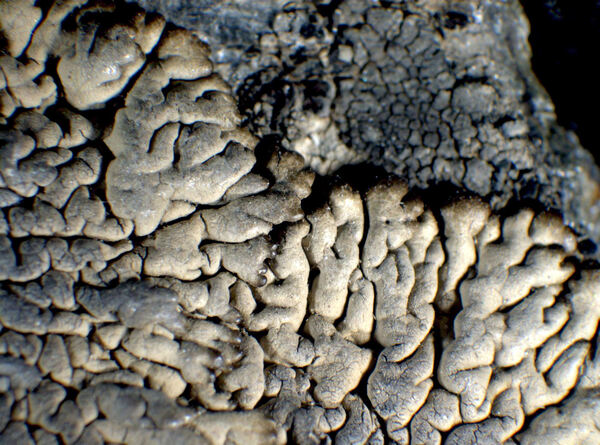Brodoa atrofusca (Schaer.) Goward
Bryologist, 89: 222, 1986. Basionym: Parmelia ceratophylla var. atrofusca Schaer. - Enum. Crit. Lich. Eur.: 42, 1850.
Synonyms: Hypogymnia atrofusca (Schaer.) Räsänen; Hypogymnia intestiniformis var. atrofusca (Schaer.) Poelt; Parmelia atrofusca (Schaer.) Cromb.; Parmelia intestiniformis var. atrofusca (Schaer.) Hasselrot
Description: Thallus foliose, heteromerous, dorsiventral, adnate, forming up to 5 (rarely more) cm wide, orbicular or irregular rosettes. Lobes 1-2 mm broad, convex, stiff, contiguous or overlapping; center of thallus sometimes with a few imbricate lobules. Upper surface pale whitish, pale grey to brownish, darkening or blackening especially on the lobules and towards the tips, somehow glossy. Lower surface black, brown toward the tips, smooth to weakly and shallowly wrinkled, erhizinate, with scattered hapters. Upper cortex paraplectenchymatous, the cell walls with Cetraria-type lichenan, with a non-pored epicortex; medulla white; lower cortex paraplectenchymatous, without an epicortex. Apothecia rare, lecanorine, up to 10 mm across, with a dark brown disc and a thin, entire to crenulate thalline margin. Epithecium brownish; hypothecium and hymenium colourless; paraphyses mostly simple. Asci 8-spored, clavate, the K/I+ blue tholus penetrated by a faintly amyloid apical cushion with parallel or diverging flanks, the wall K/I-, surrounded by a K/I+ blue outer layer, Lecanora-type. Ascospores 1-celled, hyaline, broadly ellipsoid, (7-)9-11(-12) x 6-7(-8) µm. Pycnidia numerous, immersed, the visible part black to grey-brown. Conidia bifusiform, 5-7 x c. 1 µm. Photobiont chlorococcoid. Spot tests: upper cortex K+ yellow, C-, KC-, P-; medulla K-, C-, KC+ red, P+ orange, UV-. Chemistry: upper cortex with atranorin and chloroatranorin; medulla with physodic and protocetraric acids.
Growth form: Foliose, narrow lobed
Substrata: rocks
Photobiont: green algae other than Trentepohlia
Reproductive strategy: mainly sexual
Commonnes-rarity: (info)
Alpine belt: rather rare
Subalpine belt: very rare
Montane belt: extremely rare
Dry submediterranean belt: absent
Humid submediterranean belt: absent
Padanian area: absent
pH of the substrata:
1 2 3 4 5
Solar irradiation:
1 2 3 4 5
Aridity:
1 2 3 4 5
Eutrophication:
1 2 3 4 5
Poleotolerance:
0 1 2 3
Altitudinal distribution:
1 2 3 4 5 6
Rarity
absent
extremely rare
very rare
rare
rather rare
rather common
common
very common
extremely common
Loading data...
Occurrence data
Predictive map
Growth form: Foliose, narrow lobed
Substrata: rocks
Photobiont: green algae other than Trentepohlia
Reproductive strategy: mainly sexual
Commonnes-rarity: (info)
Alpine belt: rather rare
Subalpine belt: very rare
Montane belt: extremely rare
Dry submediterranean belt: absent
Humid submediterranean belt: absent
Padanian area: absent
pH of the substrata:
| 1 | 2 | 3 | 4 | 5 |
Solar irradiation:
| 1 | 2 | 3 | 4 | 5 |
Aridity:
| 1 | 2 | 3 | 4 | 5 |
Eutrophication:
| 1 | 2 | 3 | 4 | 5 |
Poleotolerance:
| 0 | 1 | 2 | 3 |
Altitudinal distribution:
| 1 | 2 | 3 | 4 | 5 | 6 |
Rarity
absent
extremely rare
very rare
rare
rather rare
rather common
common
very common
extremely common
Loading data...
Occurrence data
Predictive map







